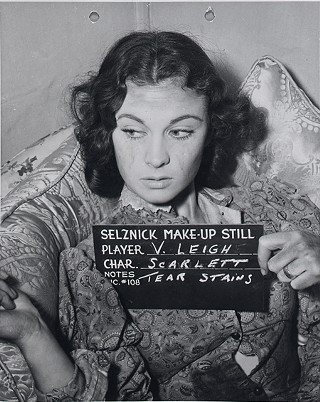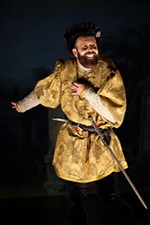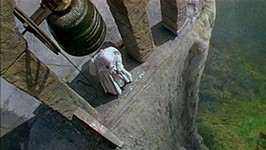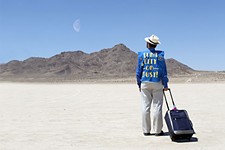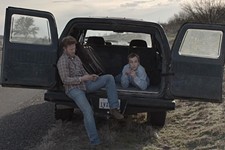History in the Making
A new exhibit at the Harry Ransom Center proves that no job is too small when it comes to 'Making Movies'
Reviewed by Kimberley Jones, Fri., Feb. 5, 2010
"Dear Bobby. You like my letters? Here's another."
So wrote Elia Kazan to Robert De Niro in a letter on the subject of The Last Tycoon, the pair's first and only project together. No doubt Bobby did like Kazan's letters,and Kazan, too – along with Martin Scorsese, he presented the director with a controversial honorary Oscar in 1999. And one could comfortably claim that those letters had at least one more fan: the archivist. Indeed, if the archivist had a vote, one imagines he'd say, "By all means, keep 'em coming."
Of course, Kazan left this mortal coil some time ago, but De Niro's collection of movie-related materials still swells and has a permanent home at the University of Texas' Harry Ransom Center. Acquired in 2006 and ranging from early head shots to more than 3,000 individual costume items, props, and a full body cast used in the 1994 production of Frankenstein, the De Niro holdings feature prominently in a new exhibit called "Making Movies," which explores the collaborative process that goes into the craft and creation of cinema.
"I didn't want to do just another memorabilia show or just, you know, highlights of the collection. I wanted to try to say something," explained Steve Wilson, the HRC's associate curator of film. "I let the materials speak for themselves. So what the collection is about is the various creative jobs that go into making a movie."
The new collection, which opens to the public Feb. 9 and features more than 350 items culled from the HRC's vast holdings, devotes distinct sections to those various creative jobs: director, screenwriter, producer, production designer, art director, actor, costume designer, hair and makeup artist, cinematographer, special effects designer, editor, and composer. Publicity and exhibition are also highlighted.
Eleven days before opening, I walked through the exhibit with Wilson, sidestepping workmen as they leveled frames on a wall. A hall to be devoted to original costumes like Scarlett O'Hara's burgundy ball gown and Travis Bickle's taxi-driver jacketwas still empty –"It's going to be pretty dramatic," Wilson assured me – but the materials already on display were hugely impressive. This is kid-in-a-candy-store stuff for any serious movie buff, where every corner turned begs a fresh exclamation: the giant scissors from Spellbound's Dalí dream sequence! Ernest Lehman's brochure from Mount Rushmore, with stage directions for North by Northwest's precipice-scaling scribbled in blue ink!
"Making Movies" is heavy on Gone With the Wind artifacts; producer David O. Selznick's papers mark the largest collection at the center, and Selznick, a notorious micromanager and memo-writer, required a lot of paper. In the producer portion of the exhibit, a preproduction chart weighs what rival studios MGM and Warner Bros. could bring to the table (respectively, Clark Gable and Errol Flynn, among other variables). Later, in the section devoted to screenwriting, a list details the pros and cons of writers considered for the Gone With the Wind gig, including Maxwell Anderson, William Faulkner ("not very reliable in his plans or habits"), Philip Barry, and Sinclair Lewis ("might be a little too political minded or a little too gin-minded"). The GWTW color scheme devised by William Cameron Menzies – for whom the term production designer was first invented – is examined in a wall of painterly storyboards. And around another corner, there's a take-your-breath-away close-up of Vivien Leigh (see photo, right) with a clapboard labeled "tear stains"; rightly worried about continuity, the filmmakers wanted to make sure they could re-create precisely the mixed streak of dirt and tear.
That image is a particular favorite of Wilson's, who told me he plans to mount the reproduction on his office wall when the exhibit goes down in August. A 20-year veteran of the HRC who previously worked at the Paramount Theatre and the long-shuttered Varsity Theatre on the Drag, Wilson labored a full year on the "Making Movies" exhibit. He pointed to a nearby display about the 1966 film Who's Afraid of Virginia Woolf?, the assemblage of which, Wilson wagered, took several weeks alone –"and we had three times as much stuff." He looked around ruefully. "I kind of have curator's remorse throughout the show of all the things that didn't make the cut."
What did make the cut: a rare early draft of the Annie Hall script. Graham Greene's original hand-typed story of The Third Man, De Niro's The Deer Hunter dialect cheat sheet for "Western Pennsylvania Language Peculiarities."
"He told me a great story," Wilson said when we reached a trove of De Niro materials. "It was sometime around [The Deer Hunter]. He was at Western Costume looking for a costume for a movie. And it's real common even today for them to recycle costumes. So he's going through these racks of clothes, and he comes across a costume for Bonnie and Clyde. And he said, 'This is wrong that they're recycling this – this is an important [artifact]!' And at that point, he started keeping everything."
The keeping of everything is a curator's dream, of course – especially when the subject exactingly labels every bric-a-brac, as was the case with screenwriter Ernest Lehman, who started sending his materials to the HRC in the early Sixties. "He wrote notes on everything," said Wilson. "In some cases, it's just kind of better to let him explain things."
But there's thrill in discovery, too, in solving the puzzle of a piece that comes in without any identifiers. Wilson showed me a wall devoted to the archival papers of Alfred Junge, the German-born production designer who worked closely with the Archers, Michael Powell and Emeric Pressburger's film collective. Wilson pointed to a page of doodlings and near-indecipherable note-taking.
"This is all Junge's handwriting. It's written on top of a letter that his son wrote to him. In corresponding with Junge's daughter-in-law, we think that this is some sort of conversation or he was brainstorming with somebody.
"On the other side there's a lot more ballet [drawings]. We think that he was having a talk maybe with [director] Michael Powell, maybe with [costume designer] Hein Heckroth. And we think they were talking about both The Red Shoes and Black Narcissus at the same time.
"But he makes these notes about Black Narcissus: 'Always just off-white.' The nuns' habits were off-white and that was kind of the famous thing he did on Black Narcissus. It brought the color palette down and it made everything look realistic because of that white not being white but being a little farther down the palette."
For Wilson, the mystery behind that slip of paper wasn't an idle curiosity; rather, it represented something integral about the filmmaking process.
"I'm always trying to show how each one of these artists involved in a film is trying to make a contribution to the characters and the story. A costume designer is not just putting clothes on but is really trying to say something through the clothes."
That fact –that movies are built on attention to the tiniest of details –is the raison d'etre of the exhibit. But if filmmakers are doing their jobs right, then most moviegoers won't even notice. "The vast majority of our collection is about mainstream Hollywood filmmaking, and that style is marked by invisibility, by not calling attention to itself and by putting the story and the characters first."
"Making Movies," then, makes that invisible work overt and, in the process, pays remarkable tribute to it.
The Harry Ransom Center's new exhibit "Making Movies" runs Feb. 9 through Aug. 1. A red carpet opening party takes place Feb. 12 for HRC members. For more information on the exhibit and how to become a member, visit www.hrc.utexas.edu.





